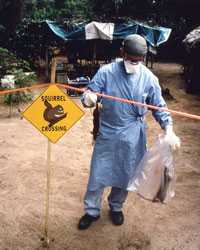Examining Animals With Suspected Monkeypox

Investigating outbreak of monkeypox in Democratic Republic of the Congo formerly Zaire, 1996–1997. Dr. Williams, D.V.M. wearing personal protection equipment (PPE) handling two newly-acquired Gambian rats.
Veterinarians who decide to treat animals with suspected monkeypox should use infection control precautions to protect themselves, staff, clients, as well as other animal patients in the clinic.
Illness presentation may vary amongst animal species. Symptoms that were observed in prairie dogs during the 2003 U.S. outbreak included cough, history of fever, conjunctivitis, lack of appetite, respiratory signs, and rash. Similar symptoms have also been observed in non-human primates that have been challenged with monkeypox virus in research studies. Some animals may experience a milder form of illness with fewer symptoms.
Animals suspected of being infected should not be allowed to enter through the waiting area of a veterinarian clinic nor should they be taken to a common treatment room. All treatment and diagnostics should be performed in an examination room. The number of staff allowed in the exam room and that come in contact with the animal should be limited to as few persons as possible.
The most common route for transmission of monkeypox from animals to humans appears to be direct contact with infected animals; however, the possibility of airborne transmission cannot be excluded. When examining animals with suspected monkeypox, veterinarians and staff should use the following precautions:
- Hand hygiene: Practice proper hand hygiene after all contact with a sick animal and with contaminated surfaces.
- Personal protective equipment: Use gown and gloves for any contact with the sick animal and contaminated surfaces. Use eye protection (e.g., tight-fitting goggles or face shield) if splash or spray of body fluids is likely. Use respiratory protection, including a NIOSH-certified N95 filtering disposable respirator (or other respirator offering comparable levels of respiratory protection), for entering the exam room or patient care area. If N95 or comparable respirators are not available for veterinary personnel, then surgical masks should be worn to protect against transmission through contact or large droplets. Handle used patient-care equipment in a manner that prevents contamination of skin and clothing.
- Waste disposal: Contain and dispose of contaminated waste after consultation with state or local health officials. Do not dispose of waste in landfills or dumps. The animal’s bedding, cage, toys, or food and water bowls should not be disposed of with the clinic trash or at a dump or landfill because this material may be potentially infectious; contact the state or local health department for further instructions. Items that cannot be disposed of should be disinfected as if they were a contaminated surface.
- Environmental cleaning: Ensure that procedures are in place for cleaning and disinfecting contaminated environmental surfaces. Any EPA-registered hospital detergent-disinfectant currently used by health-care facilities for environmental sanitation may be used. Manufacturer’s recommendations for dilution (i.e., concentration), contact time, and care in handling should be followed.
- Laundry: Wash laundry (e.g., towels, clothing) with hot water and detergent. A standard washing machine may be used. The use of chlorine bleach during hot-water washing can provide an added measure of safety. Care should be used when handling soiled laundry to avoid direct contact with contaminated material. Soiled laundry should not be shaken or otherwise handled in a manner that may disperse infectious particles.
Personal Protective Equipment Resources
- Page last reviewed: May 11, 2015
- Page last updated: May 11, 2015
- Content Source:


 ShareCompartir
ShareCompartir